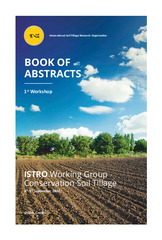Приказ основних података о документу
Variations of some antioxidants in maize grain induced by soil tillage and nitrogen rate
| dc.creator | Dragičević, Vesna | |
| dc.creator | Simić, Milena | |
| dc.creator | Vukadinovic, Jelena | |
| dc.creator | Mladenović Drinić, Snežana | |
| dc.creator | Brankov, Milan | |
| dc.creator | Kresović, Branka | |
| dc.creator | Dumanović, Zoran | |
| dc.date.accessioned | 2022-11-25T14:03:31Z | |
| dc.date.available | 2022-11-25T14:03:31Z | |
| dc.date.issued | 2020 | |
| dc.identifier.isbn | 978-953-7871-88-8 | |
| dc.identifier.uri | http://rik.mrizp.rs/handle/123456789/1065 | |
| dc.description.abstract | Soil tillage is one of the most important parts of cropping technology that affect maize growth and development. Without proper tillage, it is impossible to expect high yields. Adequate fertilization, particularly with nitrogen is also important in high yields realization. Nevertheless, the scarcity in information about the influence of tillage and nitrogen supply on kernel quality, particularly concentration of antioxidants is present. The aim of the experiment was to test the influence of different tillage practices: T1 – no-till, T2 – reduced, and T3 – conventional tillage, as well as N fertilization rate: N1 – without fertilization; N2 – 180 kg N ha-1 , 50 kg P ha-1 , 50 kg K ha-1 ; N3–240 kg N ha-1, 50 kg P ha-1, 50 kg K ha-1 , on maize grain yield and concentration of some antioxidants: phytic acid (Phy), total glutathione (GSH), phenols, tocopherols and total carotenoids. Experiment was realized during 2016-2018 period. T3 induced increase in grain yield, in comparison to T1 (averagely for 32.7%). N3 also expressed positive impact on grain yield increase, when compared to N1, in T1, T2 and T3 treatments, averagely, up to 35.3%, 45.7% and 9.4%, respectively. The highest average concentration of Phy and carotenoids was realized by T3, while the highest concentration of GSH and phenols was achieved by T1 and the highest tocopherols concentration was reached by T2 treatment. Besides, the highest average level of Phy, carotenoids and GSH was observed in N3 and the highest average concentrations of tocopherols and phenols were in N1 treatment. The significant and positive correlation between grain yield and carotenoids, GSH and phenols in all three tillage practices, as well as negative correlation between yield and Phy in T1 and T2 treatments indicated that proper tillage could increase, not just grain yield, but also nutritional quality, by increase of some antioxidants in maize kernels. | sr |
| dc.language.iso | en | sr |
| dc.publisher | Osijek : ISTRO – International soil tillage research organization | sr |
| dc.publisher | Osijek : CROSTRO – Croatian soil tillage research organization | sr |
| dc.rights | openAccess | sr |
| dc.rights.uri | https://creativecommons.org/licenses/by/4.0/ | |
| dc.source | 1. Workshop ISTRO working group "Conservation soil tillage", Osijek, 08-09.09.2020. - Book of abstracts | sr |
| dc.subject | soil tillage practices | sr |
| dc.subject | nitrogen rate | sr |
| dc.subject | antioxidants in maize grain | sr |
| dc.title | Variations of some antioxidants in maize grain induced by soil tillage and nitrogen rate | sr |
| dc.type | conferenceObject | sr |
| dc.rights.license | BY | sr |
| dc.citation.spage | 99 | |
| dc.citation.epage | 99 | |
| dc.identifier.fulltext | http://rik.mrizp.rs/bitstream/id/5968/bitstream_5968.pdf | |
| dc.identifier.rcub | https://hdl.handle.net/21.15107/rcub_rik_1065 | |
| dc.type.version | publishedVersion | sr |


